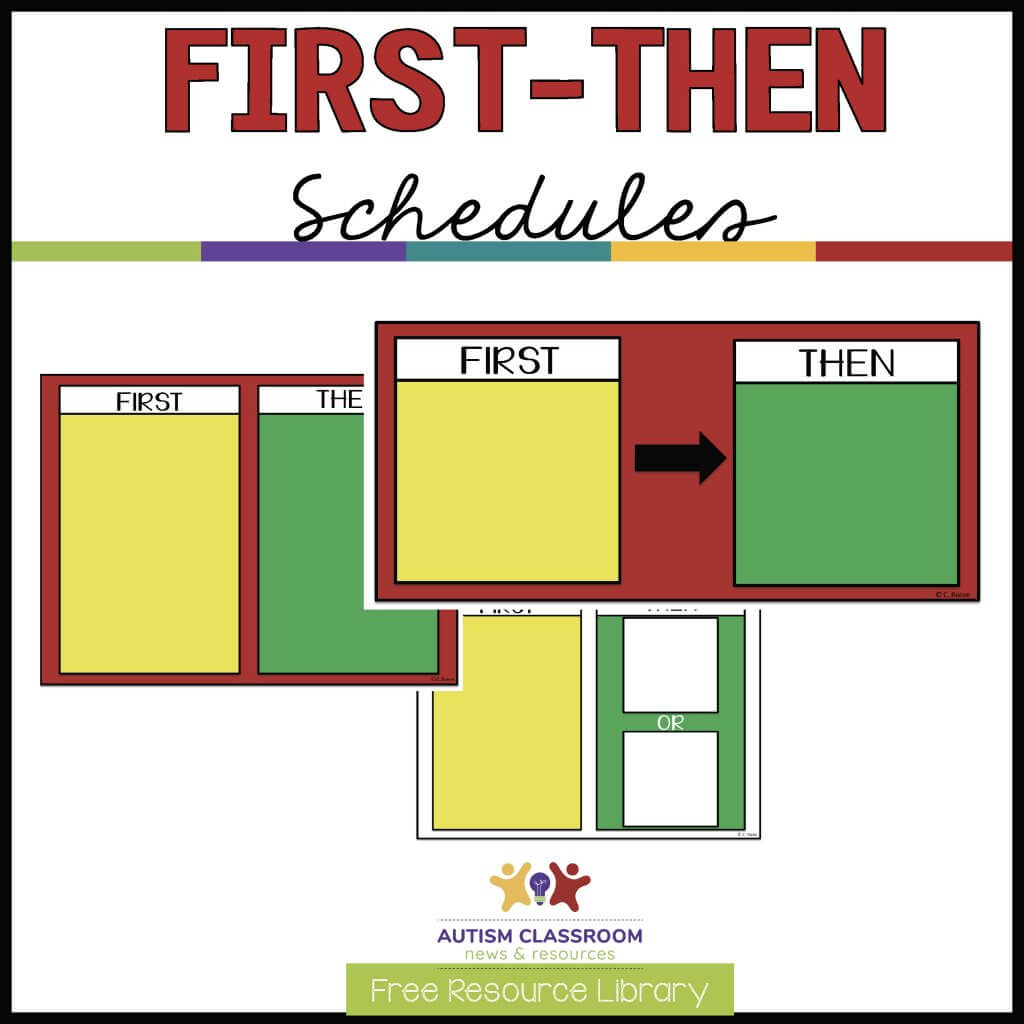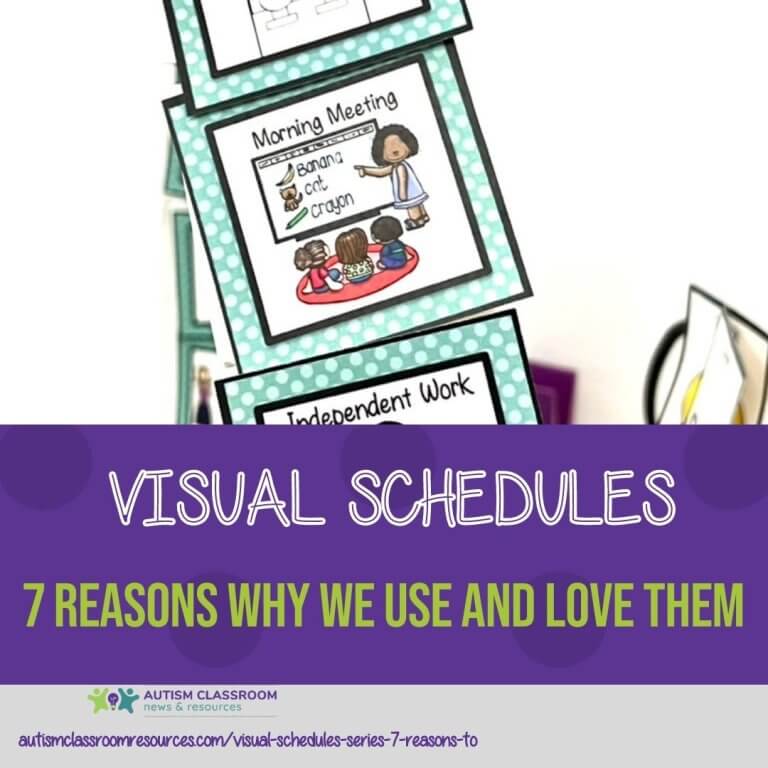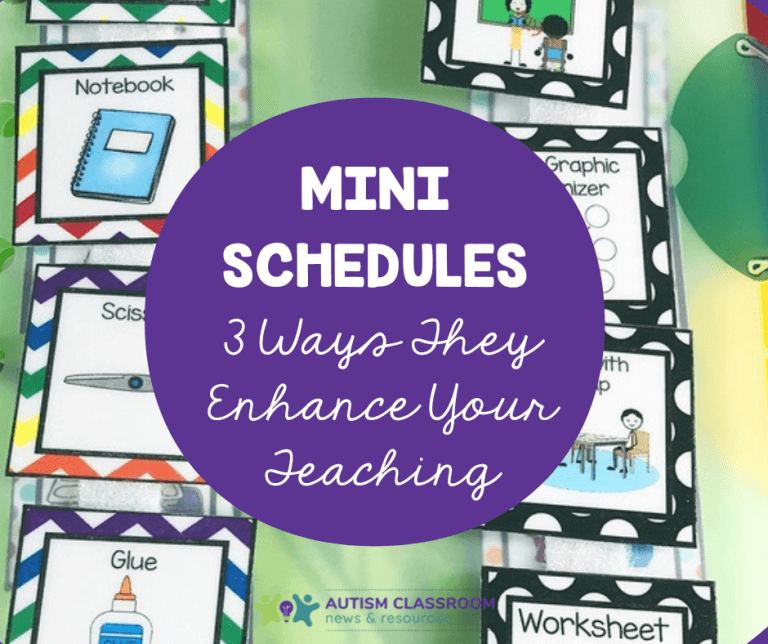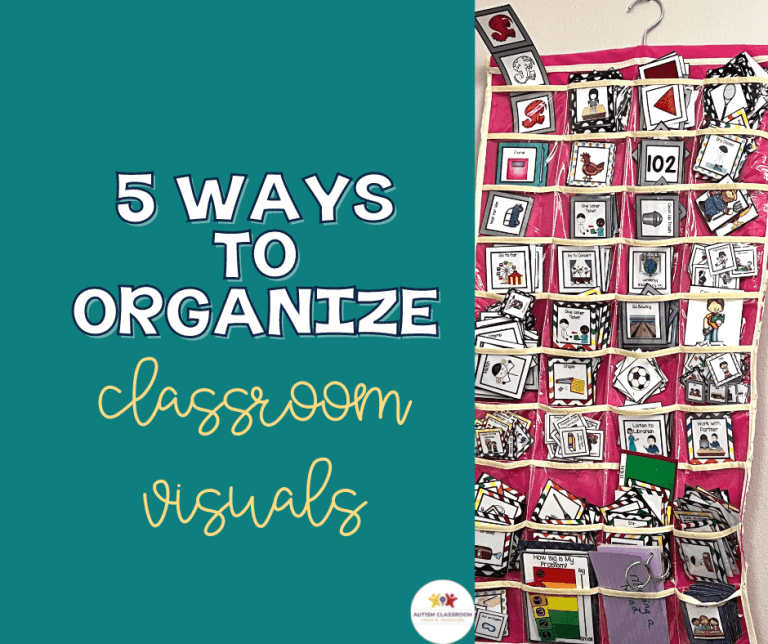Sharing is caring!

First-then schedules are some of the simplest types of visual supports that we use with students with autism spectrum disorder and other special needs. Simply put, it just presents what we need to do now (first) and what we will do next (then). It can be done with pictures, objects, in writing, or using apps. We typically use them in different ways depending on the student.
First-Then in Behavioral Support
Sometimes we use them for behavior supports, such as when we think (or know) that an individual doesn’t want to do something we want them to do. In that case, we present the thing we want them to do in the “first” and the thing they want to do in the “then.” The idea is to show them a preferred activity or a possible reinforcer to motivate them to complete the thing they don’t want to do. We often will use this type of first-then schedule on a board like the one below.
In this case we are using the first-then board to prevent problem behavior based on the Premack principle. The premack principle states that a low probability behavior can be reinforced by a high probability behavior. For instance, it’s a low probability
We use them proactively (before a problem) and when a student refuses to complete a task. Ideally it is best to use them proactively avoid having adding the preferred activity (then) in when there is a problem. Doing this could inadvertently reinforce the negative behavior (because it creates a reinforcement opportunity out of a problem).
Organizing Behavioral Supports for Travel in School
In the picture above, the first-then board is used to show a student that sitting in his PE class will result in a reward from his token board. The first then board is part of the set of tools his staff use and they keep their tools in a zip up canvas notebook (e.g., Trapper Keeper) so they are readily at hand. The student has a full day schedule on the front of the notebook and the first-then is used when a problem is anticipated. This organization system worked well because his daily activity schedules, the set of pictures to use for his first-then board, his token boards and tokens, and his schedule board (on the front of the notebook) as well as his data sheets were all handy in the notebook that he took with him to different classes.
First-Then Using the Premack Principle
A first-then board can be a powerful tool to help a student complete a task they often resist. In this case, for example, early learners may not like to clean up after play time in a preschool. So we schedule snack time after play. And we can present it on the schedule with a first then board. We can show students the first activity (cleaning up) will be followed by the next activity (snack). This uses the Premack principle of behavior analysis. In short, the Premack principle states that high-probability behaviors can serve as a reinforcer for low probability behaviors. So snack, a high probability of compliance activity, reinforces cleaning up, a low probability of compliance activity.
First-Then as a Daily Schedule

In pictures on the left, the student is using the first-then schedule as his schedule for the day. In the top picture, you see a binder with first work then pack up. For this student, we started working with him using a full-day schedule that was on the wall. In working with him for a day, we realized that he was struggling with the number of transitions this created for him. So, checking his schedule became an antecedent for problem behaviors. Each time he had to go to the wall, check the schedule, go to the check-in board and put on the visual. It was difficult for him to understand the process.
The second day we worked with him, we used this first-then schedule. The schedule itself was on the outside of a notebook. The events of his day were on sheets inside the notebook in order. This allowed the staff working with him to quickly switch out the visuals for each transition. We started with the scheduled activity being followed by a reinforcer (e.g., first work with teacher, then play dough). Over time he was able to manage the schedule with just the events of the day. And eventually he was able to go into the notebook and change his own schedule. This greatly increased his independence throughout the day.
When we first gave him the notebook, the look of comprehension that came over his face was amazing to see. It seemed as if he was saying, “Oh! Now I get it!” His behavior was significantly better using this schedule than the first one we tried. The picture below is a similar situation and you can see how we stored the schedule on the wall. This student was not able to independently manage his schedule. He did best when only shown 2 pictures at a time rather than a full-day schedule.
Caution with Daily Schedules
A word of caution, however. Don’t start an entire class on first-then notebook schedules at the same time when they haven’t been taught to use them. We tried that one time and were constantly looking for the schedules because the students weren’t independent at keeping track of them. In short, it was disaster. The next day we broke it down and just started with 2 of the students. Then we added more as the first ones became independent. You can also use first-then boards to show students what will happen after a desired activity. Helping students to know what is coming next sometimes helps them to make the transition more easily.
First-Then Doesn’t Have to be Pretty
Most students using a first-then schedule will need picture or symbol cards depicting the daily activities or the steps and reinforcers for the first-next routines. However, some students just require the structure and are readers. In that case you can use the on-the-fly option. You can just draw it out on paper, post-its or dry erase board and use writing if the student can read. Just make sure that the student is able to clearly comprehend what is written.
Implementing the First-Then Chart
When presenting the first-then schedule, as with most visual tools, try to minimize your verbal directions. Typically the teacher would give the verbal instruction one time. Then the teacher points to visuals to direct the student. The use of the nonverbal redirection reduces language overwhelming the student, can help ease anxieties, and also allows you to fade the prompts from the system more quickly than using verbal prompts. Sometimes you will need to wait the student out. Just continue to point to the visuals and wait. Depending on the situation, if the student is going to respond, they typically will do so in a few minutes. If not, then you may need to look for other options for dealing with potential challenging behaviors. But for many students, the visual first-next board can be an important first step in understanding classroom structure and following routines.
Organizing First-Then in the Classroom
Because first then boards are easy to use and typically get a quick response, I tend to put one out on every table, especially at the beginning of the school year. You want to make sure you have lots of visual supports around whenever there are changes or transitions within the year.
In addition , make sure to have a number of activity visuals available with the boards for the second activity (the preferred activities). These might come off a choice board or you might use a “make a choice” visual as an option that they can choose from a choice board. That might save you having to have a ton of visuals around.
Looking to get started with first-then boards? Simply download the boards, laminate it, and put velcro on it to hold the pictures.
SIGN UP FOR FREE TIPS EACH WEEK IN YOUR INBOX AND GRAB A FREE SET OF FIRST-THEN BOARDS FROM THE RESOURCE LIBRARY

This first-then download is expanded from the version available in my TpT Store. It includes boards in different sizes, with less color, and in black and white. And you are welcome to send them home to parents of students on your caseload.
Grab them from the Free Resource Library. Click below to navigate or join the free library.
This is part of an ongoing series of posts on different types and uses for visual schedules. You can check out the visual schedule series here.










